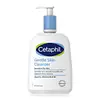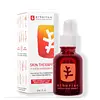What's inside
What's inside
 Key Ingredients
Key Ingredients

 Benefits
Benefits

 Concerns
Concerns

 Ingredients Side-by-side
Ingredients Side-by-side

Water
Skin ConditioningGlycerin
HumectantCaprylic/Capric Triglyceride
MaskingGluconolactone
Skin ConditioningHelianthus Annuus Seed Oil
EmollientSqualane
EmollientCoco-Caprylate/Caprate
EmollientPropanediol
SolventDicaprylyl Carbonate
EmollientButylene Glycol
HumectantArginine
MaskingPhyllostachys Bambusoides Extract
Skin Conditioning1,2-Hexanediol
Skin ConditioningCitrus Junos Fruit Extract
Skin ConditioningSodium Citrate
BufferingSodium Chloride
MaskingBetaine
HumectantZinc PCA
HumectantAvena Sativa Kernel Oil
Skin ConditioningPanax Ginseng Root Extract
EmollientOphiopogon Japonicus Root Extract
Skin ConditioningPolygonatum Officinale Rhizome/Root Extract
Skin ConditioningScrophularia Nodosa Extract
Skin ConditioningPhyllostachys Bambusoides Juice
Skin ConditioningCentella Asiatica Extract
CleansingGlycine Soja Oil
EmollientGlycyrrhiza Glabra Root Extract
BleachingCapsicum Annuum Fruit Extract
AntimicrobialDioscorea Villosa Root Extract
Skin ConditioningPolygonum Cuspidatum Root Extract
AntioxidantKigelia Africana Fruit Extract
Skin ConditioningScutellaria Baicalensis Root Extract
AstringentEquisetum Giganteum Extract
Skin ConditioningRosmarinus Officinalis Leaf Extract
AntimicrobialCamellia Sinensis Leaf Extract
AntimicrobialChamomilla Recutita Flower Extract
MaskingLactobacillus Ferment
Skin ConditioningSodium Hyaluronate
HumectantPentylene Glycol
Skin ConditioningTocopherol
AntioxidantBisabolol
MaskingCitric Acid
BufferingEthylhexylglycerin
Skin ConditioningParfum
MaskingHexyl Cinnamal
PerfumingAlpha-Isomethyl Ionone
PerfumingLinalool
PerfumingCitronellol
PerfumingWater, Glycerin, Caprylic/Capric Triglyceride, Gluconolactone, Helianthus Annuus Seed Oil, Squalane, Coco-Caprylate/Caprate, Propanediol, Dicaprylyl Carbonate, Butylene Glycol, Arginine, Phyllostachys Bambusoides Extract, 1,2-Hexanediol, Citrus Junos Fruit Extract, Sodium Citrate, Sodium Chloride, Betaine, Zinc PCA, Avena Sativa Kernel Oil, Panax Ginseng Root Extract, Ophiopogon Japonicus Root Extract, Polygonatum Officinale Rhizome/Root Extract, Scrophularia Nodosa Extract, Phyllostachys Bambusoides Juice, Centella Asiatica Extract, Glycine Soja Oil, Glycyrrhiza Glabra Root Extract, Capsicum Annuum Fruit Extract, Dioscorea Villosa Root Extract, Polygonum Cuspidatum Root Extract, Kigelia Africana Fruit Extract, Scutellaria Baicalensis Root Extract, Equisetum Giganteum Extract, Rosmarinus Officinalis Leaf Extract, Camellia Sinensis Leaf Extract, Chamomilla Recutita Flower Extract, Lactobacillus Ferment, Sodium Hyaluronate, Pentylene Glycol, Tocopherol, Bisabolol, Citric Acid, Ethylhexylglycerin, Parfum, Hexyl Cinnamal, Alpha-Isomethyl Ionone, Linalool, Citronellol
 Reviews
Reviews

Ingredients Explained
These ingredients are found in both products.
Ingredients higher up in an ingredient list are typically present in a larger amount.
Citric Acid is an alpha hydroxy acid (AHA) naturally found in citrus fruits like oranges, lemons, and limes.
Like other AHAs, citric acid can exfoliate skin by breaking down the bonds that hold dead skin cells together. This helps reveal smoother and brighter skin underneath.
However, this exfoliating effect only happens at high concentrations (20%) which can be hard to find in cosmetic products.
Due to this, citric acid is usually included in small amounts as a pH adjuster. This helps keep products slightly more acidic and compatible with skin's natural pH.
In skincare formulas, citric acid can:
While it can provide some skin benefits, research shows lactic acid and glycolic acid are generally more effective and less irritating exfoliants.
Most citric acid used in skincare today is made by fermenting sugars (usually from molasses). This synthetic version is identical to the natural citrus form but easier to stabilize and use in formulations.
Read more about some other popular AHA's here:
Learn more about Citric AcidGlycerin is already naturally found in your skin. It helps moisturize and protect your skin.
A study from 2016 found glycerin to be more effective as a humectant than AHAs and hyaluronic acid.
As a humectant, it helps the skin stay hydrated by pulling moisture to your skin. The low molecular weight of glycerin allows it to pull moisture into the deeper layers of your skin.
Hydrated skin improves your skin barrier; Your skin barrier helps protect against irritants and bacteria.
Glycerin has also been found to have antimicrobial and antiviral properties. Due to these properties, glycerin is often used in wound and burn treatments.
In cosmetics, glycerin is usually derived from plants such as soybean or palm. However, it can also be sourced from animals, such as tallow or animal fat.
This ingredient is organic, colorless, odorless, and non-toxic.
Glycerin is the name for this ingredient in American English. British English uses Glycerol/Glycerine.
Learn more about GlycerinWater. It's the most common cosmetic ingredient of all. You'll usually see it at the top of ingredient lists, meaning that it makes up the largest part of the product.
So why is it so popular? Water most often acts as a solvent - this means that it helps dissolve other ingredients into the formulation.
You'll also recognize water as that liquid we all need to stay alive. If you see this, drink a glass of water. Stay hydrated!
Learn more about Water